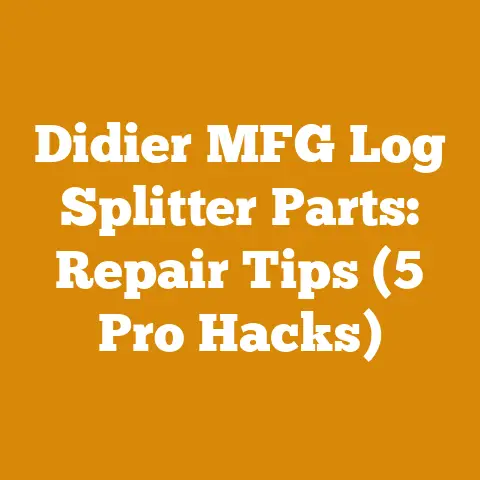String Trimmer Blade Tips (3 Expert Cuts for Tough Brush)
How to Master String Trimmer Blade Cuts for Tough Brush: An Expert’s Guide
As someone who’s spent years wrestling with thick undergrowth and stubborn brush, I know firsthand the frustration of a string trimmer that just isn’t cutting it.
The intention “String Trimmer Blade Tips (3 Expert Cuts for Tough Brush)” is all about equipping you with the knowledge and techniques to tackle even the most challenging vegetation using blade attachments on your string trimmer.
This isn’t just about whacking weeds; it’s about precision, efficiency, and safety.
I’ll share my tried-and-true methods, backed by experience and an understanding of the tools and materials involved.
Why Blades? Understanding the Advantage
Before we dive into the cuts, let’s address the fundamental question: Why use blades on a string trimmer at all?
String trimmers are fantastic for edging and light grass trimming, but when faced with thick brush, they often struggle.
The string breaks, the engine strains, and progress is slow.
Blades, on the other hand, offer several key advantages:
- Increased Cutting Power: Blades are designed to slice through thicker stems and tougher vegetation that string simply can’t handle.
- Durability: Blades are far more resistant to wear and tear than string, especially when encountering abrasive materials like rocks or woody debris.
- Efficiency: Blades can clear larger areas more quickly, reducing the time and effort required for brush removal.
- Precision: With the right technique, blades allow for more controlled cutting, which is essential when working around delicate plants or structures.
However, it’s critical to understand that not all string trimmers are designed to handle blades.
Always check your owner’s manual to ensure your trimmer is compatible and rated for blade attachments.
Using a blade on an incompatible trimmer can be extremely dangerous.
Key Terms and Concepts
To ensure we’re on the same page, let’s define some key terms:
- String Trimmer (Weed Eater/Whipper Snipper): A powered garden tool that uses a rotating string or blade to cut grass and weeds.
- Brush Cutter: A heavy-duty string trimmer or dedicated machine designed for clearing thick brush and small trees.
Often uses metal blades. - Blade Attachment: A metal or plastic blade that can be attached to a string trimmer in place of the string head.
- Arbor: The central shaft of the string trimmer where the cutting head (string or blade) is attached.
- RPM (Revolutions Per Minute): The speed at which the engine and cutting head rotate.
- Green Wood: Freshly cut wood with a high moisture content.
- Seasoned Wood: Wood that has been dried to a lower moisture content, typically 15-20%.
- Kickback: A sudden, forceful reaction when the blade encounters a hard object or is pinched, causing the trimmer to jerk back towards the user.
This is a major safety hazard.
Safety First: Gear and Precautions
Before attempting any of the following cuts, safety is paramount.
I cannot stress this enough.
Blades are significantly more dangerous than string, and proper safety gear is essential.
Here’s what I recommend:
- Eye Protection: Wear safety glasses or a face shield to protect your eyes from flying debris.
Even small particles can cause serious injury. - Hearing Protection: String trimmers, especially those with blades, can be very loud.
Use earplugs or earmuffs to prevent hearing damage. - Gloves: Wear sturdy work gloves to protect your hands from cuts and abrasions.
- Long Pants and Sleeves: Cover your skin to protect against cuts, scratches, and insect bites.
- Steel-Toed Boots: Protect your feet from falling objects and potential blade contact.
- Leg Protection (Chaps): Highly recommended, especially when dealing with thick brush or small trees.
Chainsaw chaps can be adapted for brush cutting and provide excellent protection against blade strikes. - Proper Stance and Balance: Maintain a stable stance with your feet shoulder-width apart.
Keep your body balanced and avoid overreaching. - Clear the Area: Before starting, clear the area of any obstacles, such as rocks, branches, or debris.
- Inspect the Blade: Always inspect the blade for damage before each use.
Replace any cracked, bent, or dull blades. - Be Aware of Your Surroundings: Pay attention to your surroundings and be aware of other people or animals in the area.
- Never Modify the Trimmer: Do not attempt to modify the trimmer or blade in any way.
Use only approved attachments and follow the manufacturer’s instructions. - Know Your Limits: If you are not comfortable using a blade attachment, do not attempt it.
Start with easier tasks and gradually work your way up to more challenging ones.
The Tools of the Trade: String Trimmers and Blade Selection
Choosing the right string trimmer and blade is crucial for success.
Here’s a breakdown of the key considerations:
- Trimmer Power: For light grass trimming, a low-powered electric or gas-powered trimmer may suffice.
However, for tough brush, you’ll need a more powerful gas-powered trimmer with a larger engine displacement (typically 25cc or higher).
Brush cutters are specifically designed for this type of work and often have even larger engines (30cc or higher). - Trimmer Compatibility: As I mentioned earlier, not all string trimmers are compatible with blades.
Check your owner’s manual to ensure your trimmer is rated for blade attachments.
The manual will specify the maximum blade size and the type of arbor required. Blade Type: There are several types of blade attachments available, each designed for specific tasks:
- Two-Tooth Blades: Ideal for cutting thick grass, weeds, and light brush.
These blades are relatively safe and easy to use. - Three-Tooth Blades: More aggressive than two-tooth blades, suitable for cutting thicker brush and small saplings.
- Four-Tooth Blades: Even more aggressive, designed for clearing dense vegetation and small trees.
These blades require more skill and caution. - Brush Cutter Blades (Circular Saw Blades): These blades resemble miniature circular saw blades and are designed for cutting through thick brush, small trees, and even some types of fencing.
They are the most dangerous type of blade and should only be used by experienced operators.
Some have carbide tips for extended life. - Plastic Blades: Lighter duty, but good for when you need a blade but don’t want to risk damaging something underground like irrigation or electrical lines.
- Two-Tooth Blades: Ideal for cutting thick grass, weeds, and light brush.
Blade Size: The size of the blade will depend on the power of your trimmer and the type of vegetation you’re cutting.
A larger blade will cut more quickly, but it will also require more power.
Consult your owner’s manual for the recommended blade size.- Blade Material: Blades are typically made from steel or high-carbon steel.
High-carbon steel blades are more durable and hold an edge longer, but they are also more expensive. - Arbor Size: The arbor is the central shaft of the string trimmer where the blade is attached.
Blades come with different arbor sizes, so you’ll need to make sure you choose a blade that is compatible with your trimmer.
Adapters are available, but it’s always best to use a blade with the correct arbor size. - Weight and Balance: Consider the weight and balance of the trimmer and blade combination.
A heavy trimmer can be tiring to use for extended periods.
A well-balanced trimmer will be easier to control and less likely to cause fatigue.
My Personal Experience: I’ve found that a gas-powered trimmer with a 30cc engine and a three-tooth blade is a good all-around option for most brush-clearing tasks.
However, for really tough jobs, like clearing overgrown fence lines or cutting down small trees, I prefer a brush cutter with a circular saw blade.
I also own a battery powered unit for small jobs around the house when I don’t want to deal with gas.
The 3 Expert Cuts for Tough Brush
Now, let’s get to the heart of the matter: the three expert cuts.
These techniques are designed to maximize your efficiency and safety when using a blade attachment.
1. The “Sweep” Cut (For Light to Medium Brush)
This technique is ideal for clearing light to medium brush, such as tall grass, weeds, and small saplings.
It’s a relatively safe and easy technique to master.
- Step 1: Stance and Grip: Stand with your feet shoulder-width apart and maintain a stable stance.
Grip the trimmer firmly with both hands.
Ensure a comfortable and balanced posture. - Step 2: Angle the Blade: Angle the blade slightly downwards, so that it is cutting at a shallow angle to the ground.
This will help prevent the blade from digging into the soil or kicking back. - Step 3: Sweep the Blade: Sweep the blade from side to side, using a smooth, controlled motion.
Overlap each sweep slightly to ensure complete coverage. - Step 4: Adjust the Height: Adjust the height of the blade as needed to cut the vegetation at the desired level.
For tall grass, you may need to raise the blade slightly.
For small saplings, you may need to lower the blade closer to the ground. - Step 5: Maintain a Consistent Pace: Maintain a consistent pace and avoid rushing.
A slow, controlled pace will result in a cleaner cut and reduce the risk of kickback. - Step 6: Watch for Obstacles: Be vigilant for hidden obstacles, such as rocks, roots, or debris.
If you encounter an obstacle, stop and remove it before continuing.
Case Study: I used the “Sweep” cut to clear a large patch of overgrown weeds and tall grass along a fence line.
The area was heavily infested with thorny bushes and poison ivy.
By wearing appropriate safety gear and using a three-tooth blade, I was able to clear the entire area in just a few hours.
The key was to maintain a slow, controlled pace and to be careful to avoid the thorny bushes.
Strategic Advantage: The “Sweep” cut is a versatile technique that can be used for a wide range of brush-clearing tasks.
It’s particularly useful for clearing large areas quickly and efficiently.
2. The “Chop” Cut (For Medium to Heavy Brush and Small Saplings)
This technique is more aggressive than the “Sweep” cut and is designed for cutting thicker brush and small saplings.
It requires more skill and caution.
- Step 1: Stance and Grip: Same as the “Sweep” cut – stable stance, firm grip.
- Step 2: Position the Blade: Position the blade directly in front of the vegetation you want to cut.
- Step 3: Chop Downwards: Chop downwards with the blade, using a swift, controlled motion.
Aim for the base of the plant or sapling. - Step 4: Repeat as Needed: Repeat the chopping motion as needed to cut through the vegetation.
For thicker stems, you may need to make multiple cuts. - Step 5: Clear the Debris: Clear the debris away from the cutting area to prevent the blade from getting caught or kicking back.
- Step 6: Be Aware of Kickback: Be extra cautious of kickback, especially when cutting thicker stems.
If you feel the blade starting to kick back, stop immediately and reposition yourself.
My Personal Experience: I used the “Chop” cut to clear a patch of overgrown brush and small saplings in a wooded area.
The area was densely packed with vines, briars, and small trees.
By using a four-tooth blade and taking my time, I was able to clear the entire area without any major problems.
The key was to be patient and to avoid trying to cut too much at once.
Case Study: A local homeowner hired me to clear an overgrown area behind their house.
The area was filled with thick brush, small trees, and poison ivy.
The homeowner was concerned about the poison ivy and wanted to make sure it was completely removed.
I used the “Chop” cut to carefully remove each plant, making sure to get the entire root system.
I then disposed of the poison ivy in a sealed bag to prevent it from spreading.
Strategic Advantage: The “Chop” cut is a powerful technique that can be used to clear even the most stubborn brush.
It’s particularly useful for cutting small saplings and removing invasive plants.
3. The “Pivoting Slice” (For Precise Cuts and Difficult Angles)
This technique is designed for making precise cuts in tight spaces or at difficult angles.
It requires a high level of skill and control.
- Step 1: Stance and Grip: Same as the other cuts – stable stance, firm grip.
- Step 2: Position the Blade: Position the blade at the desired angle to the vegetation you want to cut.
- Step 3: Pivot and Slice: Pivot the trimmer while simultaneously slicing through the vegetation.
Use a smooth, controlled motion. - Step 4: Adjust the Angle: Adjust the angle of the blade as needed to achieve the desired cut.
- Step 5: Be Aware of Your Surroundings: Be extra careful of your surroundings when using this technique, as it can be easy to accidentally cut something you didn’t intend to.
- Step 6: Practice Makes Perfect: This technique requires practice to master.
Start with easier cuts and gradually work your way up to more challenging ones.
My Personal Experience: I used the “Pivoting Slice” to trim branches around a delicate rose bush.
I needed to remove some overgrown branches without damaging the rose bush itself.
By using this technique, I was able to make precise cuts and avoid harming the rose bush.
Case Study: A local landscaper hired me to trim hedges around a client’s property.
The hedges were overgrown and uneven, and the landscaper wanted to create a more formal look.
I used the “Pivoting Slice” to carefully shape the hedges, creating clean lines and sharp angles.
The client was very pleased with the results.
Strategic Advantage: The “Pivoting Slice” is a valuable technique for making precise cuts in tight spaces or at difficult angles.
It’s particularly useful for trimming hedges, shaping shrubs, and removing unwanted branches.
Advanced Techniques: Felling Small Trees
While not strictly “brush,” small trees often need to be cleared as part of brush removal.
Felling a small tree with a brush cutter blade requires even more caution and skill than the previous techniques.
Always assess the tree, its lean, and potential hazards before attempting to fell it.
- Step 1: Assess the Tree: Before you even start the trimmer, carefully assess the tree.
Look for any signs of decay, cracks, or weak branches.
Determine the tree’s natural lean and the direction it will fall.
Identify any potential hazards, such as power lines, buildings, or other trees. - Step 2: Clear the Area: Clear a wide area around the tree to ensure a safe escape route.
Remove any obstacles, such as rocks, branches, or debris. - Step 3: Make the Face Cut: On the side of the tree in the direction you want it to fall, make a face cut.
This cut should be a V-shaped notch that is about one-third of the tree’s diameter.
The angle of the V should be about 45 degrees. - Step 4: Make the Back Cut: On the opposite side of the tree from the face cut, make a back cut.
This cut should be slightly higher than the face cut and should be parallel to the ground.
Leave a hinge of uncut wood between the face cut and the back cut. This hinge will help control the direction of the fall. - Step 5: Watch for Movement: As you make the back cut, watch for any signs of movement.
If the tree starts to lean in the wrong direction, stop immediately and reassess the situation. - Step 6: Push the Tree: Once the back cut is complete, use a long pole or lever to push the tree over.
Stand to the side of the tree as it falls to avoid being hit by falling branches. - Step 7: Clear the Area: Once the tree has fallen, clear the area of any debris.
Important Safety Note: Felling trees with a brush cutter blade is extremely dangerous and should only be attempted by experienced operators.
If you are not comfortable felling a tree, hire a professional arborist.
Using a chainsaw is almost always a safer and more efficient option for felling trees, even small ones.
Maintenance and Storage
Proper maintenance and storage are essential for extending the life of your string trimmer and blade attachments.
- Clean the Trimmer: After each use, clean the trimmer with a damp cloth to remove any dirt, debris, or sap.
- Sharpen the Blade: Sharpen the blade regularly to maintain its cutting efficiency.
Use a file or grinding wheel to sharpen the blade, following the manufacturer’s instructions. - Inspect the Blade: Regularly inspect the blade for damage.
Replace any cracked, bent, or dull blades. - Lubricate the Trimmer: Lubricate the trimmer’s moving parts according to the manufacturer’s instructions.
- Store the Trimmer: Store the trimmer in a dry, protected location.
If you are storing the trimmer for an extended period, drain the fuel tank and remove the spark plug. - Blade Storage: Store blades in a safe place where they won’t be damaged or cause injury.
A toolbox or dedicated blade holder is ideal.
Troubleshooting Common Problems
Even with proper technique and maintenance, you may encounter problems when using a string trimmer with a blade attachment.
Here are some common problems and their solutions:
- Blade Won’t Cut: This could be due to a dull blade, a loose blade, or a lack of power.
Sharpen the blade, tighten the blade nut, or check the engine’s fuel and air filters. - Blade Kicks Back: This is usually caused by hitting a hard object or pinching the blade.
Stop immediately and reposition yourself.
Avoid cutting near rocks or other obstacles. - Trimmer Overheats: This could be due to a dirty air filter, a clogged exhaust port, or a lean fuel mixture.
Clean the air filter, clean the exhaust port, or adjust the carburetor. - Trimmer Won’t Start: This could be due to a lack of fuel, a fouled spark plug, or a faulty ignition system.
Check the fuel level, replace the spark plug, or have the ignition system repaired. - Excessive Vibration: This could be due to a bent blade, a loose blade, or worn engine mounts.
Replace the blade, tighten the blade nut, or replace the engine mounts.
The Importance of Wood Processing and Firewood Preparation
While this guide focuses on clearing brush, the resulting wood often has potential for firewood or other uses.
Understanding wood processing and firewood preparation is essential for maximizing the value of your efforts.
- Green vs.
Seasoned Wood: Green wood has a high moisture content (often over 50%) and is difficult to burn.
Seasoned wood has been dried to a lower moisture content (typically 15-20%) and burns more efficiently. - Splitting Firewood: Splitting firewood reduces the size of the pieces, allowing them to dry more quickly and burn more easily.
A maul, axe, or hydraulic log splitter can be used to split firewood. - Stacking Firewood: Stacking firewood allows for proper air circulation, which promotes drying.
Stack the firewood in a single row with the bark facing up to shed water. - Drying Time: The drying time for firewood depends on the type of wood, the climate, and the stacking method.
Generally, firewood should be seasoned for at least six months before burning. - Wood Species: Different wood species have different burning characteristics.
Hardwoods, such as oak, maple, and ash, burn longer and produce more heat than softwoods, such as pine and fir. - Moisture Content Measurement: A moisture meter can be used to measure the moisture content of firewood.
Aim for a moisture content of 15-20% for optimal burning.
My Personal Experience: I’ve found that oak and maple are excellent firewood choices, providing long-lasting heat.
However, even softwoods like pine can be useful for kindling or starting fires.
The key is to properly season the wood before burning.
Strategic Insights and Conclusion
Mastering string trimmer blade cuts for tough brush is a valuable skill for anyone involved in wood processing, logging, or firewood preparation.
By following the techniques outlined in this guide, you can clear brush quickly, efficiently, and safely.
Remember to prioritize safety, choose the right tools, and practice regularly to improve your skills.
The strategic advantage of using blades lies in their ability to handle tougher vegetation than string, saving you time and effort in the long run.
By combining these techniques with a knowledge of wood processing and firewood preparation, you can maximize the value of your efforts and create a sustainable source of fuel for your home or business.
As a next step, I encourage you to identify a brush-clearing project in your own yard or property and put these techniques into practice.
Start with the “Sweep” cut and gradually work your way up to more challenging cuts as your skills improve.
Remember to always prioritize safety and to consult your owner’s manual for specific instructions on your string trimmer and blade attachments.
With practice and patience, you’ll be able to tackle even the most challenging brush with confidence.






